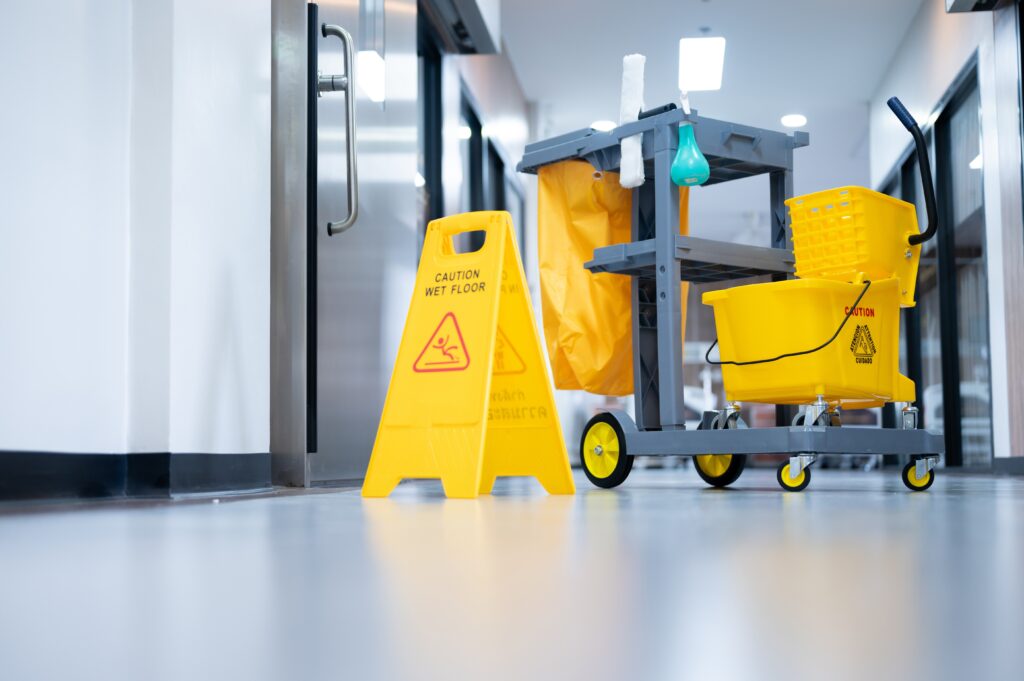Health care-associated infections are a preventable burden. A recent randomised controlled trial presents evidence on how enhanced cleaning and disinfection can reduce infection rates.
It is estimated that one in ten adult inpatients in Australia acquire a health care-associated infection (HAI), equating to over 160 000 HAIs annually. Despite the significant morbidity and mortality associated with HAIs, there is a lack of robust evidence supporting effective infection prevention interventions. Research has shown that patients who are admitted to a room previously occupied by a patient infected and/or colonised with a pathogen, are at higher risk of acquiring that pathogen. It is well known that some pathogens can survive on inanimate surfaces for several months, indicating that the hospital environment plays a crucial role in pathogen transmission.
A seminal Australian study published in 2019, conducted in 11 hospitals (REACH study), demonstrated that improvements in routine hospital cleaning resulted in reduced HAI rates. This research was the first cluster randomised control trial to evaluate the effect of a cleaning bundle on the incidence of HAIs. The REACH study did not, however, focus on the cleaning of shared medical equipment.
The role of shared medical equipment, such as commodes, infusion drip stands, pumps and blood pressure monitors, in transmitting infections is not fully understood. In 2018, an Australian study provided molecular evidence, via whole genome sequencing, that shared medical equipment plays a critical role in the transmission of infectious pathogens in hospitals. Although all hospitals have cleaning protocols, there is still uncertainty about who is responsible for cleaning shared medical equipment and the impact cleaning may have on patient outcomes. This is a problem faced by hospitals globally. Clinicians who use the equipment may lack the time or knowledge to clean it thoroughly, while environmental staff are not usually responsible for cleaning shared equipment or are aware when the equipment has been used.

Groundbreaking research
The CLEaning and Enhanced disiNfection (CLEEN) study investigated the impact of enhanced cleaning and disinfection of shared medical equipment on HAIs in a large hospital in New South Wales, Australia. For the study, we conducted a stepped-wedge, randomised control trial across ten wards in one New South Wales public hospital, incrementally transitioning from the control phase (existing cleaning practices) to the intervention phase (multimodal intervention).
The multimodal intervention encompassed three key strategies – an additional three hours of the dedicated cleaning of shared medical equipment per weekday per ward, education and audit and feedback. The Therapeutic Goods Administration-approved 2-in-1 detergent and disinfectant wipes were used to clean shared equipment. Staff received education and training sessions prior to the commencement of the intervention, where the principles of cleaning were taught and practised. To assess the thoroughness of cleaning, routine audits were carried out in the control and intervention phases, using fluorescent markers. Fluorescent markers are invisible to the naked eye, but can be seen using a specialised torch. Pieces of shared medical equipment were considered thoroughly cleaned if the fluorescent marks were removed after 24 hours. Marks are easily removed when cleaned appropriately. This allowed at least one opportunity for the equipment to be cleaned in a 24-hour period. During the intervention phase, the results from audits were communicated back to staff involved in the training and used to deliver and tailor refresher training sessions. In the control phase, clinicians were responsible for cleaning shared equipment after use, a practice that is common in most hospitals across the world.
The person responsible for data collection was blinded to the intervention allocation. Every fortnight, all inpatients on a study ward were assessed for any HAI, against European Centre for Disease Control definitions using an approach successfully undertaken in a past Australian study. Inter- and intra-rater reliability testing was undertaken.
The study involved 5002 patients, distributed between equal time periods during the control and intervention phases. In unadjusted results, 433 confirmed HAI cases occurred in 2497 patients in the control phase and 301 confirmed HAI cases occurred in 2508 patients in the intervention phase. In adjusted results, there was a relative reduction of 34.5% in HAIs following the intervention, corresponding to an absolute reduction of 5.2%. This significant reduction underscores the effectiveness of enhanced cleaning practices. Cleaning audit data demonstrated a 211% increase in the thoroughness of cleaning in the intervention, compared to existing cleaning practices. In the control phase, on average, equipment was cleaned only 25% of the time — once a day. Some key pieces of equipment were cleaned much less. This is an importantly low figure, given that cleaning is supposed to occur after every use.
One major strength of this study was its rigorous design, using a stepped-wedge model that allowed each ward to serve as its own control, minimising confounding variables. Other variables, such as hand hygiene compliance rates and the number of patients under transmission-based precautions, were also monitored. Additionally, auditing of cleaning practices helped ensure intervention fidelity. As the study was conducted in only one hospital, generalisability may be limited.
Our study highlights the critical role that consistent, thorough cleaning and disinfection plays in reducing HAIs, suggesting that similar interventions could be widely adopted in health care facilities.
Going forward
The costs of implementing our study were not significant, approximately $100 000 for staffing, education, auditing and additional product costs. However, for the cost of less than a 1.0 full-time equivalent nurse, we found considerable benefits for patients and the health service. We will formally report a cost-effectiveness evaluation in the coming months. Nonetheless, we can confidently say that our study was cost-effective, saving health services money as well as improving important patient outcomes. Cleaning services are often the first to get cut when budgets are tight. A decision maker that forgoes the opportunity to invest in this intervention risks wasting health care money and the opportunity to reduce risks for patients. Cleaning of shared equipment takes considerable time. The reliance on clinical staff as the only cleaners of shared medical equipment runs the risk of this cleaning not occurring, a key finding from the control phase of our study. In the era of antimicrobial resistance, prevention of infections is key. We call for health services to find ways to improve the cleaning and disinfection of shared medical equipment. When cleaning is improved, it will reduce the risk of HAIs for patients as well as freeing up valuable bed days used to treat patients with infections.
Dr Kate Browne is a postdoctoral research fellow at Avondale University and the clinical trial coordinator for the CLEEN study.
Professor Phil Russo is an adjunct professor at Avondale University and a chief investigator for the CLEEN study. He is also the director of research, nursing and midwifery at Monash University, and the director of nursing research at Cabrini Health.
Professor Brett Mitchell AM is a professor of nursing and health services research at Avondale University and the principal investigator for the CLEEN study. He is also a professor of nursing, school of nursing and midwifery, Monash University; and honorary professor, school of nursing and midwifery, University of Newcastle, Infection Research Program, Hunter Medical Research Institute and Conjoint, Central Coast Local Health District, NSW.
The statements or opinions expressed in this article reflect the views of the authors and do not necessarily represent the official policy of the AMA, the MJA or InSight+ unless so stated.
Subscribe to the free InSight+ weekly newsletter here. It is available to all readers, not just registered medical practitioners.
If you would like to submit an article for consideration, send a Word version to mjainsight-editor@ampco.com.au.

 more_vert
more_vert
Congratulations to the Authors and Team members who participated in this study. One of the most practical and useful studies on Prevention in infection control and every hospital can and should be able to implement this protocol. I suspect the costs will be recooped by the prevention of only a handful of SSI or 1-2 serious HIA that need hospital admission.
I can probably explain the biology of why cleaning in this manner decreases patient cross-infection. My team (ref) were the first to demonstrate that bacteria, contained within biofilms, can be found on common healthcare surfaced in an ICU unit. Surfaces such as permanent pillow & mattress protectors, bedside storage containers, bedside privacy curtains, etc. Bacteria in biofilms attached the these surfaces can happily sit, almost in stasis, until a future patient comes into contact with them and the under the right biological situation with be reactivated and transfer to their clothing/skin/lines, etc. This was the first paper that demonstrated “Dry-film” biofilm on clinical surfaces. This had been hypothesised but never proven. Subsequent papers have demonstrated that this is one (very) important mechanism in transfer of clinically important MRO from one patient to another.
Effective cleaning protocols to minimise/prevent & dare I say it REMOVE these dry-surface bacterial biofilms on common clinical surfaces might be the next important step in decreasing the patient-to-patient transfer of deadly & clinically important MROs. This paper is probably one of the first to demonstrate that this can be achieved with a more thorough & detailed cleaning regimen – underpinned by education, support and valuing the team who perform this very important job.
ref:
Intensive care unit environmental surfaces are contaminated by multidrug-resistant bacteria in biofilms: combined results of conventional culture, pyrosequencing, scanning electron microscopy, and confocal laser microscopy
H. Hu, K. Johani, I. B. Gosbell, A. S. Jacombs, A. Almatroudi, G. S. Whiteley, et al.
Journal of Hospital Infection 2015 Vol. 91 Issue 1 Pages 35-44
DOI: 10.1016/j.jhin.2015.05.016